Wikipedia:Picture of the day/September 2019
|
Featured picture tools: |
These featured pictures, as scheduled below, appeared as the picture of the day (POTD) on the English Wikipedia's Main Page in September 2019. Individual sections for each day on this page can be linked to with the day number as the anchor name (e.g. [[Wikipedia:Picture of the day/September 2019#1]] for September 1).
You can add an automatically updating POTD template to your user page using {{Pic of the day}} (version with blurb) or {{POTD}} (version without blurb). For instructions on how to make custom POTD layouts, see Wikipedia:Picture of the day.
September 1

|
British propaganda during World War II was created by the Ministry of Information, which was recreated for the duration of World War II to generate propaganda to influence the population towards support for the war effort. A wide range of media was employed aimed at local and overseas audiences. Traditional forms such as newspapers and posters were joined by new media including cinema, newsreels and radio. A wide range of themes were addressed, fostering hostility to the enemy, support for allies, and specific pro-war projects such as conserving metal and growing vegetables. This picture is a British propaganda poster warning against careless talk, which discouraged talking about sensitive material where it could be overheard by spies. The poster, produced by the pseudonymous artist "Whitear", depicts a glamorous woman seated on a bar stool making eye contact with the viewer, representing a conventional glamour spy, accompanied by the text "You forget – but she remembers" and "Careless talk costs lives". Poster credit: "Whitear"
Recently featured: |
September 2

|
The pied kingfisher (Ceryle rudis) is a species of water kingfisher that is widely distributed across Africa and Asia. Originally described by Linnaeus in 1758, it has five recognised subspecies. Its black and white plumage and crest, as well as its habit of hovering over clear lakes and rivers before diving for fish, make it distinctive. Males have a double band across the breast, while females have a single gorget that is often broken in the middle. They are usually found in pairs or small family groups. When perched, they often bob their head and flick up their tail. This picture shows a female C. r. leucomelanurus individual. Photograph credit: Charles J. Sharp
Recently featured: |
September 3

|
The Entombment is a 1559 oil-on-canvas painting by the Italian artist Titian, commissioned by Philip II of Spain. It depicts the burial of Jesus in a stone sarcophagus, which is decorated with depictions of Cain and Abel and the binding of Isaac. The figure holding Christ's body is Nicodemus, the Jewish elder that secretly visited Jesus at night to learn about his teachings; the figure of Nicodemus bears the traits of the artist himself. This could have been inspired by Michelangelo's idea in his unfinished Deposition from 1550, depicting himself as Nicodemus, supporting the body of Christ, displayed in the cathedral in Florence. The painting exhibits a style under development by Titian at the time, characterized by the use of broad brushwork and brilliant colours. It is now in the permanent collection of the Museo del Prado, Madrid. Painting credit: Titian
Recently featured: |
September 4

|
Wells Cathedral is an Anglican cathedral in Wells, Somerset, commenced around 1175; it is predominantly built in the Early English style. This interior view shows the nave, looking towards the altar. The arcade, which takes the same form in the nave, choir and transepts, is distinguished by the richness of both mouldings and carvings. Each pier of the arcade has a surface enrichment of 24 slender shafts in eight groups of three, rising beyond the capitals to form the deeply undulating mouldings of the arches. The capitals themselves are remarkable for the vitality of the stylised foliage, in a style known as "stiff-leaf". The liveliness contrasts with the formality of the moulded shafts and the smooth unbroken areas of ashlar masonry in the spandrels. Each capital is different, and some contain small figures illustrating narratives. The vault of the nave rises steeply in a simple quadripartite form, in harmony with the nave arcade. The eastern end of the choir was extended and the whole upper part elaborated in the second quarter of the 14th century by William Joy. The choir vault has a multiplicity of ribs in a net-like form, which is very different from that of the nave, and is perhaps a recreation in stone of a local type of compartmented wooden roof of which examples remain from the 15th century, including those at St Cuthbert's Church, Wells. The vaults of the aisles of the choir also have a unique pattern. Photograph credit: David Iliff
Recently featured: |
September 5

|
Mammillaria spinosissima, also known as the spiny pincushion cactus, is a species of flowering plant in the cactus family, Cactaceae, endemic to the central Mexican states of Guerrero and Morelos, where they grow at elevations of approximately 1,600 to 1,900 metres (5,200 to 6,200 ft). The species was described in 1838 by James Forbes, gardener of the Duke of Bedford. Botanist David Hunt collected a specimen in 1971, when he located one near Sierra de Tepoztlan, Mexico. The cylindrical and elongated plants grow up to 30 centimetres (12 in) tall and 10 centimetres (3.9 in) wide. They reach full height after five to ten years. The spines are red-brown or white, with cream-colored radials and pink, funnel-shaped flowers that grow in a ring around the apex of the stem to approximately 2 centimetres (0.79 in) long. It grows low to the ground in solitary or in clusters, and its flowers produce generally bright red berries that are club-shaped, smooth, and juicy. This picture shows an M. spinosissima cactus of the 'rubrispina' ('Super Red') variety. Photograph credit: Rationalobserver
Recently featured: |
September 6

|
Jane Addams (September 6, 1860 – May 21, 1935) was an American settlement activist, reformer, social worker, sociologist, public administrator and author. She was a notable figure in the history of social work and women's suffrage in the United States and an advocate for world peace. She co-founded Chicago's Hull House, one of America's most famous settlement houses. In 1910, Addams was awarded an honorary master of arts degree from Yale University, becoming the first woman to receive an honorary degree from the school. In 1920, she was a co-founder for the American Civil Liberties Union. In 1931, she became the first American woman to be awarded the Nobel Peace Prize, and is recognized as the founder of the social work profession in the United States. She is increasingly being recognized as a member of the American pragmatist school of philosophy, and is known by many as the first woman "public philosopher in the history of the United States". Photograph credit: Bain News Service; restored by Adam Cuerden
Recently featured: |
September 7

|
The Cuban peso is one of two official currencies in use in Cuba, the other being the convertible peso. Most Cuban state workers receive their wages in national pesos, but some receive a portion of their salary in convertible pesos. Shops that sell basic necessities, such as groceries, generally accept only national pesos, whereas convertible pesos are much more commonplace in "dollar shops", which sell non-essential commodities and goods. The word "peso" may refer to either currency. This picture shows a five-peso coin, dated 1915, containing on average 8.3592 grams (0.29486 oz) of gold (.900 fine), depicting José Martí on the obverse and the coat of arms of Cuba on the reverse. The coin was engraved by Chief Engraver of the United States Mint Charles E. Barber and struck at the Philadelphia Mint. Coin credit: Charles E. Barber and the Philadelphia Mint; photographed by the National Numismatic Collection
Recently featured: |
September 8

|
|
The 2017 Atlantic hurricane season was a hyperactive tropical cyclone season and the costliest on record, with a damage total of at least $282.02 billion (2017 USD). Featuring 17 named storms, 10 hurricanes and 6 major hurricanes, 2017 had the fifth-most named storms since reliable records began in 1851 – tied with 1936 – and the most major hurricanes since 2005. Collectively, the tropical cyclones were responsible for at least 3,364 deaths – the most fatalities in a single season since 2005. Most of the season's damage was due to hurricanes Harvey, Irma and Maria. Another notable hurricane, Nate, was the worst natural disaster in Costa Rican history. The names Harvey, Irma, Maria and Nate were retired following the season due to the number of deaths and amount of damage they caused. This season is also one of only six years on record to feature multiple Category 5 hurricanes and the only season other than 2007 with two hurricanes making landfall at that intensity. All ten of the season's hurricanes occurred in a row – the greatest number of consecutive hurricanes in the satellite era, and tied for the highest number of consecutive hurricanes ever observed in the Atlantic basin. A hyperactive season, 2017 had the highest accumulated cyclone energy (ACE) since 2005, while a record three hurricanes each had an ACE of over 40: Irma, Jose and Maria. This picture, taken by the VIIRS instrument on the National Oceanic and Atmospheric Administration's Suomi NPP satellite on September 8, 2017, shows three hurricanes simultaneously active in the western Atlantic: Katia (left) making landfall in the Mexican state of Veracruz, Irma (center) approaching Cuba, and Jose (right) northeast of the Leeward Islands at peak intensity. Photograph credit: National Oceanic and Atmospheric Administration
Recently featured: |
September 9
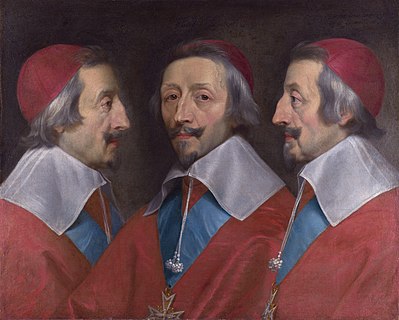
|
Cardinal Richelieu (9 September 1585 – 4 December 1642) was a French clergyman and statesman. He was consecrated as a bishop in 1607 and was appointed foreign secretary in 1616. Richelieu soon rose in both the Catholic Church and the French government, becoming a cardinal in 1622 and King Louis XIII's chief minister in 1624. He remained in office until his death in 1642; he was succeeded by Cardinal Mazarin, whose career he had fostered. This picture is an oil-on-canvas painting by French artist Philippe de Champaigne, entitled Triple Portrait of Cardinal de Richelieu, completed c. 1642. The portrait shows the cardinal from three angles: right profile, face-on, and left profile. Aged nearly 60, he wears a scarlet liturgical skullcap (zucchetto) and cape (mozzetta). Under the broad collar of a white shirt, tied at the neck with a trailing string, is the characteristic blue ribbon of the Order of the Holy Spirit, from which hangs the Maltese cross of the order as a pectoral cross. The painting is now in the collection of the National Gallery, London. Painting credit: Philippe de Champaigne
Recently featured: |
September 10
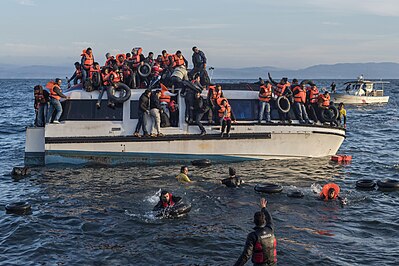
|
The European migrant crisis, also known as the refugee crisis, is a period beginning in 2015 characterised by high numbers of people arriving in the European Union from across the Mediterranean Sea or overland through Southeast Europe following Turkey's migrant crisis. It is part of a pattern of increased immigration to Europe from other continents, which began in the mid-20th century and which has encountered resistance in many European countries. This picture shows Syrian and Iraqi refugees disembarking a boat upon reaching the coastal waters of the island of Lesbos, Greece, after having crossed the Mytilini Strait from Turkey. They are being assisted by volunteer lifeguards, in yellow and red clothes, from Proactiva Open Arms, a Spanish non-governmental organisation. Photograph credit: Georgios Giannopoulos
Recently featured: |
September 11

|
The collapse of the World Trade Center in New York City occurred as a result of the terrorist attacks of September 11, 2001, after the buildings were struck by two hijacked commercial airliners. The North Tower was hit at 8:46 am and collapsed at 10:28 am. The South Tower was hit at 9:03 am and collapsed at 9:59 am. The resulting debris severely damaged or destroyed more than a dozen other adjacent and nearby structures, ultimately leading to the collapse of Seven World Trade Center at 5:21 pm. This picture, taken four days after the collapse, shows a New York City fireman calling for ten more rescue workers to make their way into the rubble of the World Trade Center. Photograph credit: Preston Keres; retouched by Lise Broer
Recently featured: |
September 12

|
Mae Jemison (born 1956) is an American engineer, physician and former NASA astronaut. She became the first black woman to travel in space when she served as a mission specialist aboard the Space Shuttle Endeavour. Jemison joined NASA's astronaut corps in 1987 and was selected to serve for the STS-47 mission, during which she orbited the Earth for nearly eight days on September 12–20, 1992. Born in Alabama and raised in Chicago, Jemison graduated from Stanford University with degrees in chemical engineering as well as African and African-American studies. She then earned her medical degree from Cornell University. Jemison was a doctor for the Peace Corps in Liberia and Sierra Leone from 1983 until 1985 and worked as a general practitioner. In pursuit of becoming an astronaut, she applied to NASA. Jemison left NASA in 1993 and founded a technology research company. She later formed a non-profit educational foundation and through the foundation is the principal of the 100 Year Starship project funded by DARPA. Jemison has also written several books for children and appeared on television several times, including in an episode of Star Trek: The Next Generation. She holds several honorary doctorates and has been inducted into the National Women's Hall of Fame and the International Space Hall of Fame. This picture is Jemison's official NASA portrait, taken in 1992, prior to her STS-47 spaceflight; she is depicted in her Launch Entry Suit. Photograph credit: NASA
Recently featured: |
September 13

|
Atractomorpha is a genus of grasshopper in the family Pyrgomorphidae, found in Africa, Asia and Australia. The genus name is derived from Greek and means 'spindle-shaped' or 'arrow-shaped', referring to the cone-shaped head found in individuals of the genus. Atractomorpha are active during the day, and their usual habitat is reeds and grasses close to rivers or streams. This picture shows a grasshopper of the species A. crenulata, commonly known as the tobacco grasshopper, which has a distribution from South Asia to Vietnam. Photograph credit: Chris Woodrich
Recently featured: |
September 14

|
A promotional flyer for Lagu Kenangan ('Song of Memories'), a 1953 Indonesian film directed by L. Inata and produced by Djamaluddin Malik for the Persari Film Corporation. Starring Titien Sumarni and A. N. Alcaff, the film tells the story of a composer, Supardi, who lives with his wife, Surjati, and their two children Janti and Janto. The couple often fight, owing to Supardi's late hours, as he does his best work at night when the children are sleeping. Things escalate to the point that Surjati takes Janti and leaves. This separation nearly ends in divorce, but eventually with the support of their parents, Surjati and Supardi are able to reconcile. The film was one in a long line of commercially oriented ventures which had been produced by the Persari Film Corporation, starting with Sedap Malam in 1950. Flyer credit: Persari Film Corporation; image restored by Chris Woodrich
Recently featured: |
September 15

|
St. Jerome in His Study is an oil-on-panel painting by the Italian Renaissance master Antonello da Messina, thought to have been completed around 1460 to 1475 during Antonello's Venetian sojourn. The small picture portrays Saint Jerome working in his studio, a room without walls and ceiling seen from a kind of triumphal arch (probably within some church of Aragonese style). As in several other works by the Messinese painter, the main scene is accompanied by a host of details that have points of contact with the contemporary Flemish school: books, animals and objects painted with a taste for detail and "optical truth". The painting is now in the collection of the National Gallery in London. Painting credit: Antonello da Messina
Recently featured: |
September 16

|
The Iranian toman is a superunit of the official currency of Iran, the rial. One toman is equivalent to ten rials. Although the rial is the official currency, Iranians use the toman in everyday life. This picture shows a ten-toman gold coin dated AH 1314 (c. 1896), depicting Mozaffar ad-Din, shah of the Qajar dynasty, on the obverse. Coin credit: Tehran Mint; photographed by the National Numismatic Collection
Recently featured: |
September 17
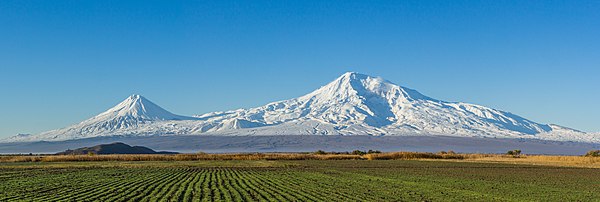
|
|
Mount Ararat is a snow-capped and dormant compound volcano in the extreme east of Turkey. It consists of two major volcanic cones: Greater Ararat and Little Ararat. Greater Ararat is the highest peak in Turkey and the Armenian plateau, with an elevation of 5,137 m (16,854 ft); Little Ararat's elevation is 3,896 m (12,782 ft). The Ararat massif is about 35 km (22 mi) wide at ground base. The first efforts to reach Ararat's summit were made in the Middle Ages. However, it was not until 1829 when Friedrich Parrot and Khachatur Abovian, accompanied by four others, made the first recorded ascent. Despite the scholarly consensus that the "mountains of Ararat" of the Book of Genesis (8:4) do not refer specifically to Mount Ararat, it has been widely accepted in Christianity as the resting place of Noah's Ark. It is the principal national symbol of Armenia and has been considered a sacred mountain by Armenians. It is featured prominently in Armenian literature and art and is an icon for Armenian irredentism. Along with Noah's Ark, it is depicted on the coat of arms of Armenia. This picture is a panorama of Mount Ararat and the Ararat Plain as seen from near the city of Artashat, Armenia, showing both Little Ararat (left) and Greater Ararat (right). The historic Khor Virap monastery can be seen in the background on the far left. Photograph credit: Serouj Ourishian
Recently featured: |
September 18
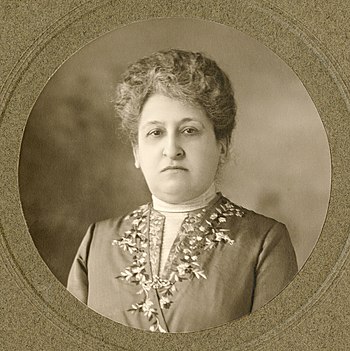
|
Aletta Jacobs (1854–1929) was a Dutch physician and women's suffrage activist. Jacobs strove throughout her life to change laws that limited women's access to equality, starting in 1883 with an unsuccessful court challenge and eventually achieving success 100 years ago today, on 18 September 1919, with the signing of a suffrage bill into law. She is also noted for founding the world's first birth control clinic, in 1882. As a child Jacobs yearned to become a doctor like her father and, despite existing barriers, she fought to gain entry to higher education and became the first woman officially to attend a Dutch university, and one of the first female physicians in the Netherlands. Providing medical services to women and children, she grew concerned over the health of working women, and although she continued to practice medicine until 1903, she increasingly turned her attention to activism with a view to improving women's lives. In addition to her suffrage work she led campaigns aimed at deregulating prostitution, improving women's working conditions, and promoting peace. Photograph credit: Max Büttinghausen; restored by Adam Cuerden
Recently featured: |
September 19

|
Battus polydamas, also known as the gold rim swallowtail, the Polydamas swallowtail or the tailless swallowtail, is a species of butterfly in the family Papilionidae, found in the neotropic ecozone of South America, the southeastern U.S. and Mexico. The species was first described by Carl Linnaeus in his 10th edition of Systema Naturae, published in 1758. Its wingspan is 90 to 120 mm (3.5 to 4.7 in) without the tail. The oversides of the wings are black, with a broad submarginal band formed by large yellow spots. The undersides of the forewings have the same pattern, while the hindwings have a submarginal row of red lunules. The larvae feed on Aristolochia plant species. This picture shows the underside of a B. p. jamaicensis butterfly, a subspecies endemic to Jamaica. Photograph credit: Charles J. Sharp
Recently featured: |
September 20

|
The Kiss is an oil-on-canvas painting with added gold leaf, silver and platinum by Austrian Symbolist painter Gustav Klimt. It was painted at some point in 1907 and 1908, during the height of what scholars call Klimt's "Golden Period". The painting depicts a couple embracing each other, their bodies entwined in elaborate beautiful robes decorated in a style influenced by the contemporary Art Nouveau style and the organic forms of the earlier Arts and Crafts movement. Despite an ongoing controversy regarding Klimt's three-part Vienna Ceiling series, which was criticized as pornographic, The Kiss was enthusiastically received and was purchased, still unfinished, by the Austrian government when it was put on public exhibition. The painting is considered by scholars to be a masterpiece of Vienna Secession. It now hangs in the Österreichische Galerie Belvedere museum in the Belvedere, Vienna. Painting credit: Gustav Klimt
Recently featured: |
September 21

|
Dried bark strips, bark powder and dried flowers of the small tree Cinnamomum verum. Native to Sri Lanka, C. verum, also known as true cinnamon, is an evergreen of the family Lauraceae. The tree's inner bark is used to make the spice cinnamon, although most of the world's supply comes from several other Cinnamomum species. Sri Lanka produces 80 to 90 per cent of C. verum cinnamon; the tree is also cultivated commercially in the Seychelles and Madagascar. Photograph credit: Simon A. Eugster
Recently featured: |
September 22

|
Elizabeth L. Gardner (1921–2011) was an American pilot during World War II who served as a member of the Women Airforce Service Pilots (WASP). Gardner was born in Rockford, Illinois, and graduated from Rockford High School in 1939. She was a mother and housewife before the war started. After she married, she took the last name Remba. Upon enlisting as a WASP member, Gardner "had two days of training under Lieutenant Col. Paul Tibbets, who later commanded the B-29 that dropped the first atom bomb on Hiroshima". She flew Martin B-26 Marauder medium bombers, including the AT-23 trainer version of the bomber. One of her stations was in Dodge City, Kansas. She was trained as a test pilot and flight instructor, and she also flew aircraft that towed aerial targets. After years of fighting for recognition of their military service, the 300 surviving WASP pilots were recognized with the Congressional Gold Medal in 2009. This picture shows Gardner sitting in the pilot's seat of a Martin B-26 Marauder at Harlingen Army Airfield, Texas. The often-reproduced photograph was taken when she was about 22 and became emblematic of the place of women in the service of their country. Photograph credit: United States Department of the Air Force; restored by Hohum and Bammesk
Recently featured: |
September 23

|
Neptune is the eighth and farthest known planet from the Sun in the Solar System. In the Solar System, it is the fourth-largest planet by diameter, the third-most-massive planet and the densest giant planet. Neptune is 17 times the mass of Earth, slightly more massive than its near-twin Uranus. Neptune is denser and physically smaller than Uranus because its greater mass causes more gravitational compression of its atmosphere. Neptune orbits the Sun once every 164.8 years at an average distance of 30.1 au (4.5 billion km; 2.8 billion mi). It is named after the Roman god of the sea and has the astronomical symbol ♆, a stylised version of the god Neptune's trident. This picture of Neptune was taken by NASA's Voyager 2 spacecraft in 1989, at a range of 4.4 million miles (7.1 million kilometres) from the planet, approximately four days before closest approach. The photograph shows the Great Dark Spot, a storm about the size of Earth, in the centre, while the fast-moving bright feature nicknamed the "Scooter" and the Small Dark Spot can be seen on the western limb. These clouds were seen to persist for as long as the spacecraft's cameras could resolve them.
Recently featured: |
September 24
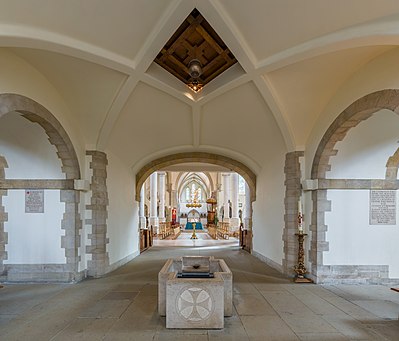
|
Portsmouth Cathedral, officially known as the Cathedral Church of St Thomas of Canterbury, is an Anglican cathedral church in Portsmouth, England. It is the cathedral of the Diocese of Portsmouth and the seat of the bishop of Portsmouth. The cruciform building was constructed in the Romanesque style on land donated by Norman lord Jean de Gisors in the 1180s and dedicated to Saint Thomas Becket, who was martyred around ten years earlier. It was made a cathedral upon the establishment of the Diocese of Portsmouth, which was split from the Diocese of Winchester in 1927, after which it was extended in a "Neo-Byzantine" style by Charles Nicholson. This picture shows the cathedral's chancel, which, along with the transepts, are the only remaining sections of the original medieval building. The baptismal font, made to a ninth-century Greek design, is placed in the centre. Photograph credit: David Iliff
Recently featured: |
September 25

|
The Barbican Estate is a residential estate that was built during the 1960s and the 1980s within the City of London in Central London, in an area once devastated by World War II bombings and today densely populated by financial institutions. It contains, or is adjacent to, the Barbican Arts Centre, the Museum of London, the Guildhall School of Music and Drama, the Barbican public library, the City of London School for Girls and a YMCA (now closed), forming the Barbican Complex. The complex is a prominent example of British Brutalist architecture and is Grade II listed as a whole with the exception of the former Milton Court. Milton Court, which once contained a fire station, medical facilities, and some flats, was demolished to allow the construction of a new apartment tower named The Heron, which also contains additional facilities for the Guildhall School of Music and Drama. This picture shows Lauderdale Tower, one of three residential towers in the estate, all at a height of 42 storeys and 123 m (404 ft). The top two or three floors of each block comprise three penthouse flats. Once the tallest residential towers in London, they were surpassed by the Pan Peninsula development on the Isle of Dogs. Photograph credit: Daniel Case
Recently featured: |
September 26

|
Saints Cosmas and Damian were two Arab physicians, reputedly twin brothers, and early Christian martyrs. They practised their profession in the seaport of Aegeae, then in the Roman province of Syria. Accepting no payment for their services led to them being named anargyroi ('unmercenaries'); it has been said that, by this, they attracted many to the Christian faith. During the persecution under Diocletian, Cosmas and Damian were arrested by order of the prefect of Cilicia, one Lysias who is otherwise unknown, who ordered them under torture to recant. However, according to legend, they stayed true to their faith, enduring being hung on a cross, stoned and shot by arrows and finally suffering execution by beheading. Anthimus, Leontius and Euprepius, their younger brothers, who were inseparable from them throughout life, shared in their martyrdom. This picture is an icon of Saints Cosmas and Damian, painted by French miniature painter and manuscript illuminator Jean Bourdichon for the Grandes Heures of Anne of Brittany, a book of hours produced in the early 16th century. Cosmas (left) is depicted with a urine bottle, while Damian (right) holds a medicine box. The icon, as well as the book of hours, is in the collection of the Bibliothèque nationale de France. Icon credit: Jean Bourdichon
Recently featured: |
September 27
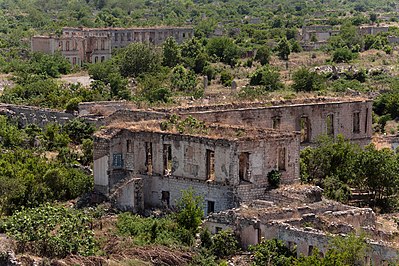
|
Aghdam is a ghost town in the southwest part of Azerbaijan and the formal capital of its Agdam District, today controlled by the de facto Republic of Artsakh, but de jure internationally recognized territory of the Republic of Azerbaijan. Armenian forces captured Agdam in July 1993 during the Nagorno-Karabakh War. The heavy fighting forced the entire population to flee eastwards. Upon seizing the city, Nagorno-Karabakh Republic forces destroyed much of the town to discourage Azerbaijanis from returning. More damage occurred in the following decades when locals looted the abandoned town for building materials. It is currently almost entirely ruined and uninhabited. Photograph credit: KennyOMG
Recently featured: |
September 28
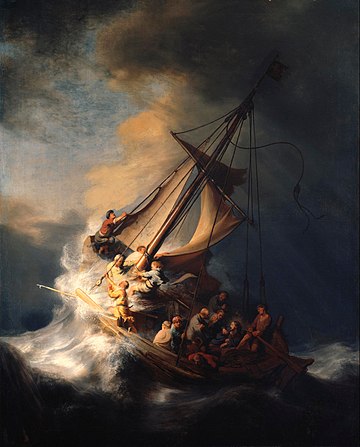
|
The Storm on the Sea of Galilee is a 1633 oil-on-canvas painting by the Dutch Golden Age painter Rembrandt van Rijn. The painting depicts the miracle of Jesus calming the storm on the Sea of Galilee, specifically as it is described in the fourth chapter of the Gospel of Mark. It is Rembrandt's only seascape. The work was previously in the Isabella Stewart Gardner Museum in Boston, but on the morning of March 18, 1990, two thieves disguised as police officers broke into the museum and stole the painting and twelve other works in what is considered to be the biggest art theft in U.S. history. The museum still displays the paintings' empty frames in their original locations and the heist remains unsolved. In 2013, the FBI announced that they knew who was responsible for the crime. Criminal analysis has suggested that the heist was committed by an organized crime group. There have been no conclusions made public, as the investigation is ongoing. Painting credit: Rembrandt
Recently featured: |
September 29

|
|
The Mazda6 is a mid-size car produced by Mazda since 2002, replacing the long-produced Capella/626. The car was popular among consumers, selling faster than all previous Mazda models. The Mazda6 was marketed as the first example of the company's "Stylish, Insightful, and Spirited" design philosophy, followed by the Mazda2 in December 2002, the RX-8 in August 2003, the Mazda3 in January 2004, the Mazda5 in the summer of 2005, the MX-5 in October 2005, and the CX-7 in November 2006. The 2003 Mazda6 is essentially the sixth generation Mazda 626, as the Mazda6 continues on the G platform, progressing from the GF-platform 626/Capella to the GG-platform Mazda6. This picture shows a 2003 Mazda6 hatchback in Classic trim. Photograph credit: John O'Neill
Recently featured: |
September 30

|
The gentoo penguin (Pygoscelis papua) is a penguin species in the genus Pygoscelis, most closely related to the Adélie penguin and the chinstrap penguin. The earliest scientific description was made in 1781 by Johann Reinhold Forster with a reference point of the Falkland Islands. They call in a variety of ways, but the most frequently heard is a loud trumpeting which the bird emits with its head thrown back. The gentoo penguin is easily recognized by the wide white stripe extending like a bonnet across the top of its head and its bright orange-red bill. It has pale whitish-pink webbed feet and a fairly long tail – the most prominent tail of all penguin species. Chicks have grey backs with white fronts. As the gentoo penguin waddles along on land, its tail sticks out behind, sweeping from side to side, hence the scientific name Pygoscelis, which means 'rump-tailed'. Photograph credit: Andrew Shiva
Recently featured: |
Picture of the day archives and future dates
